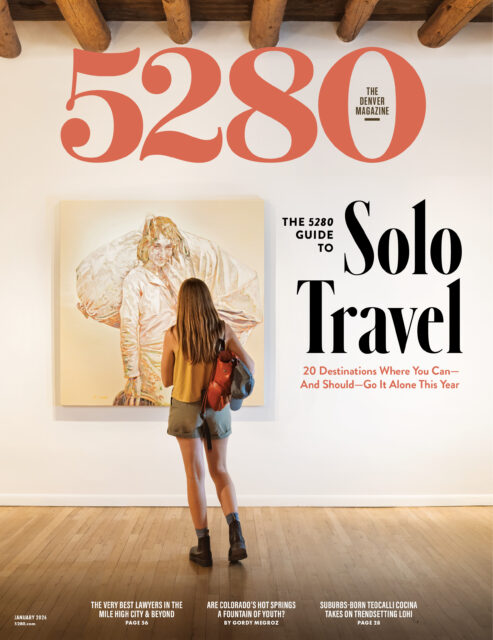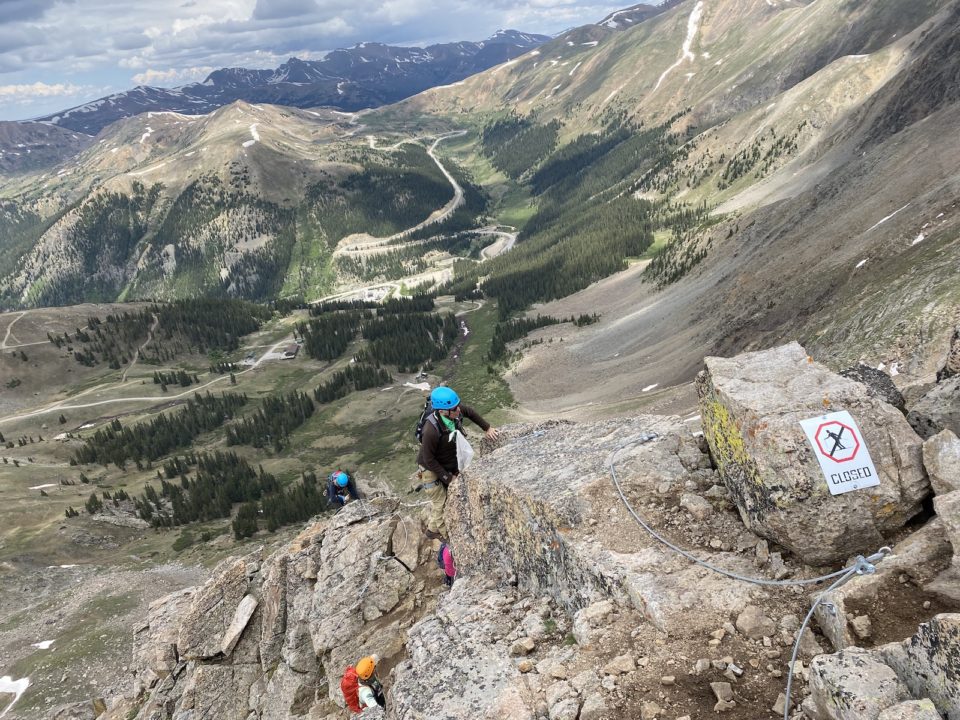The Local newsletter is your free, daily guide to life in Colorado. For locals, by locals.
I figured a via ferrata at Arapahoe Basin Ski Area would be no walk in the park—nothing is at the resort, which is famous for its steep ski runs and extreme winter sports competitions. Still, it turned out that A-Basin’s new climbing experience—the highest via ferrata in North America—is far more rugged and thrilling than I imagined.
The adventure involves a guided, 800-foot vertical (I mean, truly vertical) climb up the granite cliffs of the Basin’s East Wall. After summiting above 13,000 feet, you get to enjoy a gourmet picnic at the top, before turning around to down climb a similar route to the starting point below.

When I showed up with the recommended provisions (warm layers, rain jacket, sturdy footwear, gloves, water, and sunscreen), the ferrata had been open for four days, two of which were curtailed by heavy afternoon thunderstorms. As someone who doesn’t like heights and has minimal rock-climbing experience, I was slightly hesitant.
My newbie anxiety was momentarily quelled, though, when I learned that no previous experience is required and that even 12-year-olds are permitted. I was also fleetingly relieved to discover that my group included a 76-year-old grandfather from California. Bob (the grandfather) was treating his daughter-in-law (Bonnie) and college-aged granddaughter (Phoebe) to their first-ever via ferrata experience. It wasn’t long, however, before I learned about Bob’s impressive mountaineering track record and status as the family daredevil. He has spent his life scaling towering peaks all over the world, including making 62 summits of the 14,500-foot Mt. Whitney.
That’s the type of grandpa that shows up for this sort of thing. And while previous via ferrata experience might not be necessary, a certain base level of fitness—not to mention grit—absolutely is.
After a chairlift ride to mid-mountain and an ATV trek farther up the ski area’s service road, we were dropped off at around 12,000 feet to begin our adventure. McKenzie, a young Colorado native with obvious outdoor skills, including serious rock-climbing achievements and backpacking experience, served as our guide. She is the only female via ferrata guide among A-Basin’s team of eight. Fitted with climbing harnesses, carabiners, and helmets, the five of us (the maximum allowed per group) began hiking the high tundra toward the colossal cliffs. We stepped from rock to rock across talus fields and lingering snowdrifts, carefully avoiding the colorful clusters of vibrant wildflowers growing in the moss and smiling at the intermittent squeaks of marmots and pikas.
Perhaps the most hardcore aspect of a via ferrata is that your safety is entirely self-regulated. You are responsible for clipping the carabiners of your harness onto one cable after another along the route. In the event of a slip, this prevents what could be a 600-foot plunge to certain death below. You are essentially rock climbing with the help of iron rungs and footholds cemented strategically into the cliff along the way (in Italian, via ferrata translates as “iron path”).

It was immediately apparent that the placement of the rungs and footholds left plenty of room for challenge. There were numerous places where it was necessary to work my way up (and later down) by fitting a foot or hand carefully into a narrow crack for support, straddling inch-wide ledges, gripping natural handholds, and hoisting myself toward the next step or grip. Mckenzie, upbeat and positive, was helpful in providing input on the best lines and moves in tricky sections throughout the journey, which was made more challenging by the ominous black clouds building above.
At one point, an entire herd of mountain goats peered down at us from high above and, as instructed, we had to yell rock! a few times to warn the others below about loose fragments tumbling down the cliffs, including a couple of frighteningly large pieces.
Due to the intense focus and concentration required, not to mention the sweeping, bird’s-eye views of the slopes, the Continental Divide, and surrounding 14,000-foot peaks (including Grays and Torreys), the three-hour ascent flew by.
Because of the darkening sky, we didn’t linger long at the top. But we did take a few minutes to enjoy the picnic lunch: an antipasto spread of grilled bread, cheese, olives, almonds, and salami that put my usual high-altitude snack—a smashed peanut butter and jelly—to shame. While sitting on the mossy tundra, we also got a good look at the dizzying walls we’d just scaled.
Then came the climb down, which proved to be the real challenge. Whereas on the way up, even the most acrophobic among us could focus on the immediate task at hand—the rock, rung, and cable directly in view—on the way down, it was impossible to block out the 800 feet of open air and ant-sized terrain below, especially as the rock and metal became increasingly slippery with frozen precipitation.
Although the down-climb route is slightly gentler than the ascent, there were sections where we had to lie flat on our bellies against the wet rock, gripping with full strength and weight on the cable. At two sections, McKenzie’s rock-climbing skills and gear came in handy as she put us on individual belay ropes for backup down the slick walls.
As McKenzie’s radio buzzed with updates on the storm (luckily the lightning stayed several miles away), we slowly made our way down, the total descent clocking in at well over three hours. The warm layers, gloves, and rain jacket proved clutch as we were all totally soaked and covered in mud by the time we piled into the delightfully warm Suburban for the drive down the mountain. Everyone remained in good spirits. Bonnie joked that it wouldn’t be an adventure with her father-in-law if there weren’t a death-defying element involved, and even Bob admitted that of his decades of mountaineering exploits, this one was uniquely riveting.
Now that I’ve experienced a via ferrata, I can say with certainty that A-Basin’s iron path is definitely not for the weak-hearted. But that doesn’t mean that I don’t want to do it again.
(Read More: New Summer Adventures in the Colorado Mountains)








